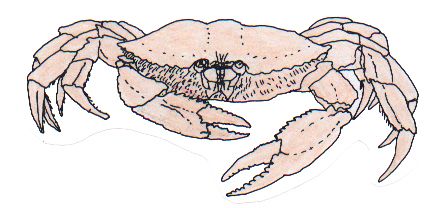 Marshall
Cultural Atlas Marshall
Cultural Atlas
This collection of student work is from
Frank Keim's classes. He has wanted to share these works for others
to use as an example of Culturally-based curriculum and documentation. These
documents have been OCR-scanned. These are available
for educational use only.
The Dungeness Crab
(Cancer magister)
(Pupsulek)
The Dungeness crab is a well known shellfish which
is found on the open coast and inside salt waters of Alaska. It can
be found as far north as 61 degrees N. latitude and south to
Magdelena Bay, Mexico.
This crab is named for a coastal fishing village
in Washington called Dungeness. It has a flattened body that is
covered by a hard chitonous shell, and two if its 10 legs have large
pincers. It is related to shrimp, lobster and other crabs. The
Dungeness crab can be told apart from other commercially important
crabs, such as the King crab and the Tanner crab, because its legs
are smaller and shorter compared to its body size. A large male
Dungeness crab can be nine inches or more in shell width. The
predicted life span of this crab is approximately eight
years.
When the mature male and female mate, the female
stores the sperm for several weeks or until her eggs are fully
developed. She then projects the eggs out onto her abdominal flap
where they are fertilized. A large female crab can carry 2.5 million
eggs. After three or four years of being alive, the young crabs will
be sexually mature.
Dungeness crabs like living on a sandy or muddy
bottom in salt water. However, they are very tolerant to salinity
changes, so they can also be found in bays and estuaries where fresh
water mixes with salt water. Large amounts of Dungeness crabs can be
found in water of less than 10 fathoms, but they have been found in
depths down to 100 fathoms.
These shellfish can be caught for sport, but they
are mostly caught commercially.
Rose Lynn
Fitka

Christmastime Tales
Stories real and imaginary about Christmas, Slavik, and the New Year
Winter, 1996 |
Christmastime Tales II
Stories about Christmas, Slavik, and the New Year
Winter, 1998 |
Christmastime Tales III
Stories about Christmas, Slavik, and the New Year
Winter, 2000 |
| Summer Time Tails 1992 |
Summertime Tails II 1993 |
Summertime Tails III |
| Summertime Tails IV Fall, 1995 |
Summertime Tails V Fall, 1996 |
Summertime Tails VI Fall, 1997 |
| Summertime Tails VII Fall, 1999 |
Signs of the Times November 1996 |
Creative Stories From Creative Imaginations |
| Mustang Mind Manglers - Stories of the Far Out,
the Frightening and the Fantastic 1993 |
Yupik Gourmet - A Book of
Recipes |
|
| M&M Monthly |
|
|
| Happy Moose Hunting! September Edition 1997 |
Happy Easter! March/April 1998 |
Merry Christmas December Edition 1997 |
| Happy Valentine’s
Day! February Edition
1998 |
Happy Easter! March/April Edition 2000 |
Happy Thanksgiving Nov. Edition, 1997 |
| Happy Halloween October 1997 Edition |
Edible and Useful Plants of Scammon
Bay |
Edible Plants of Hooper Bay 1981 |
| The Flowers of Scammon Bay Alaska |
Poems of Hooper Bay |
Scammon Bay (Upward Bound Students) |
| Family Trees and the Buzzy Lord |
It takes a Village - A guide for parents May 1997 |
People in Our Community |
| Buildings and Personalities of
Marshall |
Marshall Village PROFILE |
Qigeckalleq Pellullermeng ‘A
Glimpse of the Past’ |
| Raven’s
Stories Spring 1995 |
Bird Stories from Scammon Bay |
The Sea Around Us |
| Ellamyua - The Great Weather - Stories about the
Weather Spring 1996 |
Moose Fire - Stories and Poems about Moose November,
1998 |
Bears Bees and Bald Eagles Winter 1992-1993 |
| Fish Fire and Water - Stories about fish, global warming
and the future November, 1997 |
Wolf Fire - Stories and Poems about Wolves |
Bear Fire - Stories and Poems about Bears Spring,
1992 |
|